A BIG-IP Administrator is setting up a new BIG-IP device. The network administrator reports that the interface has an incompatible media speed. The BIG-IP Administrator needs to change this setting
manually.
From which location should the BIG-IP Administrator perform this task?
An LTM Specialist is customizing local traffic logging.
Which traffic management OS alert level provides the most detail?
The LTM device is configured for RADIUS authentication. Remote logins are failing and the LTM Specialist must verify the RADIUS configuration.
How should the LTM Specialist check the RADIUS server and shared secret configured on the LTM device?
An LTM device has a virtual server configured as a Performance Layer 4 virtual listening on 0.0.0.0:0 to perform routing of packets to an upstream router. The client machine at IP address 192.168.0.4 is attempting to contact a host upstream of the LTM device on IP address 10.0.0.99.
The network flow is asymmetrical, and the following TCP capture displays:
# tcpdump -nnni 0.0 'host 192.168.0.4 and host 10.0.0.99'
tcpdump: verbose output suppressed, use -v or -vv for full protocol decode
listening on 0.0, link-type EN10MB (Ethernet), capture size 96 bytes
05:07:55.499954 IP 192.168.0.4.35345 > 10.0.0.99.443: S 3205656213:3205656213(0) ack 3267995082 win 1480
05:07:55.499983 IP 10.0.0.99.443 > 192.168.0.4.35345: R 1:1(0) ack 1 win 0
05:07:56.499960 IP 192.168.0.4.35345 > 10.0.0.99.443: S 3205656213:3205656213(0) ack 3267995082 win 1480
05:07:56.499990 IP 10.0.0.99.443 > 192.168.0.4.35345: R 1:1(0) ack 1 win 0
4 packets captured
Which option within the fastL4 profile needs to be enabled by the LTM Specialist to prevent the LTM device from rejecting the flow?
An application is expected to maintain more than 100,000concurrent TCP connections to a single pool member.
What is an appropriate SNAT configuration in this situation?
A web application is configured as follows:
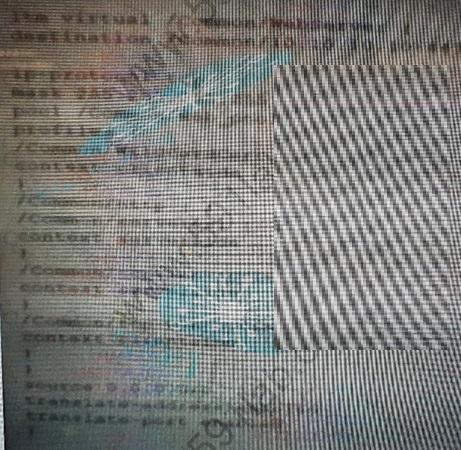
What should be modified to set a maximum request limit?
The output of a tmsh command is: ------------------------------------------------------------ Net::Interface Name Status Bits Bits Errs Errs Drops Drops Colli In Out In Out In Out sions ------------------------------------------------------------ 1.1 down 0 0 0 0 0 0 0 1.2 up 191.4K 0 0 0 374 0 0 1.3 down 0 0 0 0 0 0 0 1.4 up 22.5K 0 0 0 44 0 0 2.1 miss 0 0 0 0 0 0 0 2.2 miss 0 0 0 0 0 0 0 mgmt up 43.2G 160.0G 0 0 0 0 0
Which command was executed on the LTM device to show the output?
-- Exhibit –
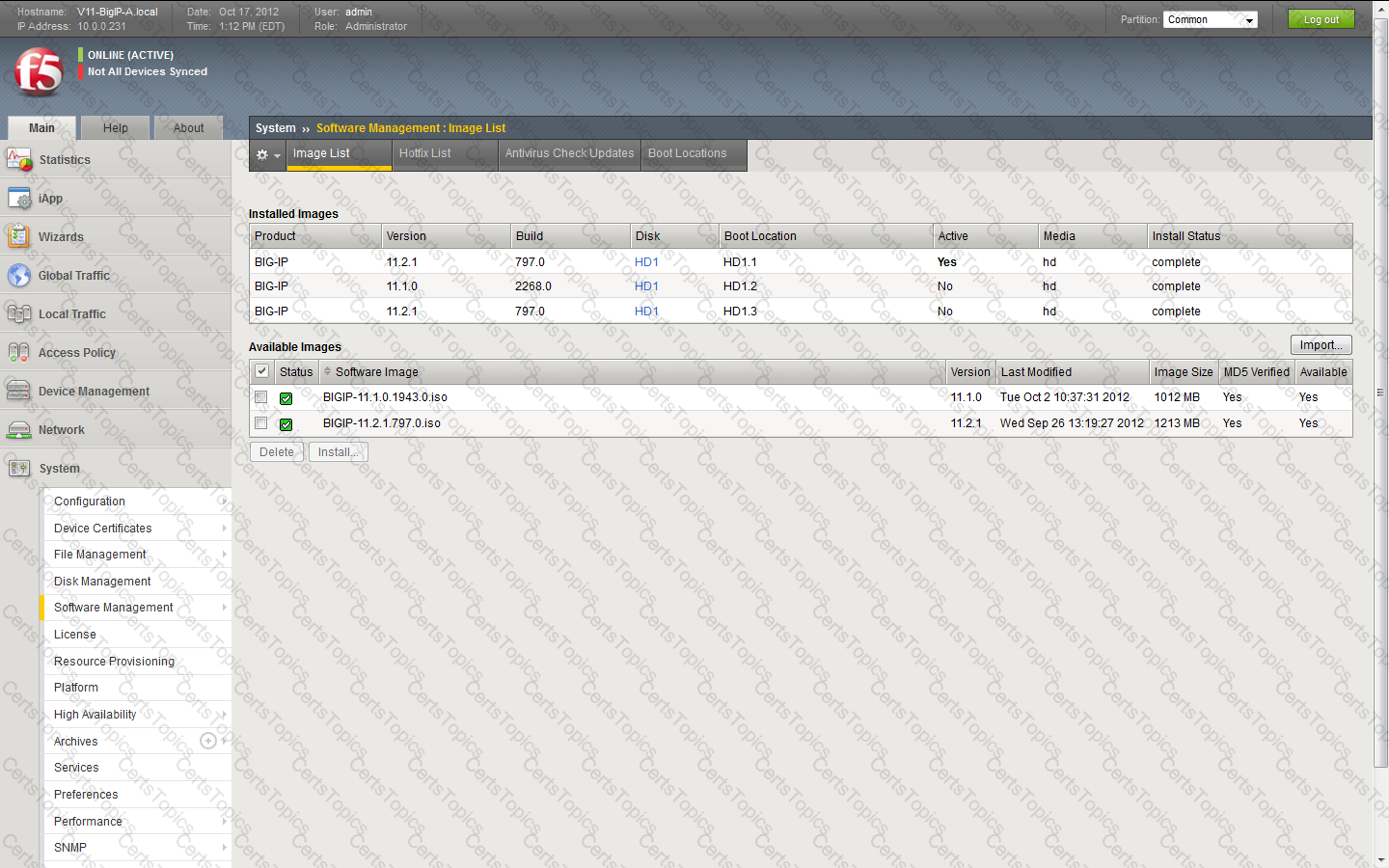
-- Exhibit --
Refer to the exhibit.
An LTM Specialist has uploaded a qkview to F5 iHealth.
Within the GUI, what is the correct procedure to comply with the recommendation shown in the exhibit?
An LTM Specialist plans to enable connection mirroring for a virtualserver in an HA environment.
What must the LTM Specialist consider before implementing the configuration change?
An LTM Specialist needs to configure a virtual server with the requirements displayed below.
Application is currently an internal HTTPapplication
Encrypted external user access
Links are hard for siteA example.com and need to rewritten to siteB.Example.com
Which profiles must the LTM Specialist use to provide the proper functionality?
An LTM Specialist is troubleshooting virtual server 10.0.0.1:443 residing on VLAN vlan301. The web application is accessed via The LTM Specialist wants to save a packet capture with complete decrypted payload for external analysis.
Which command should the LTM Specialist execute on the LTM device command line interface?
-- Exhibit –
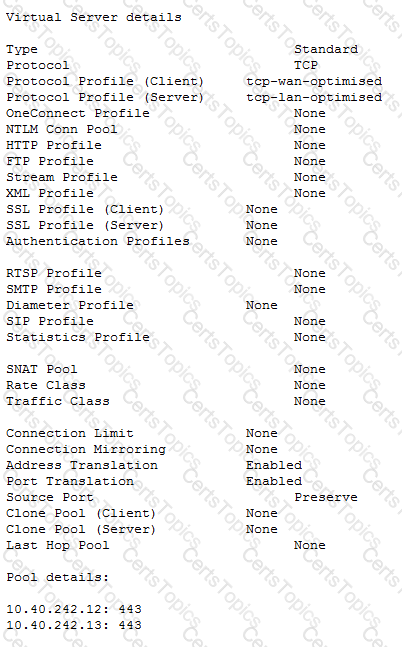
-- Exhibit --
Refer to the exhibit.
An LTM device is used to load balance web content over a secure channel.
The developers of the web content have done a trace using an HTTP profiler application. They believe that allowing the LTM device to compress traffic to the client will improve performance. The client can utilize GZIP or deflate compression algorithms.
An LTM Specialist must implement the compression.
The LTM Specialist has completed the following actions:
1. Create the relevant profile.
2. Apply the relevant profile to the virtual server (VS).
After applying the relevant profile, the LTM device is failing to compress the traffic. Instead, the traffic is being served with an error.
What is the problem?
A VLAN has the following objects configured:
Self-IP 10.10.10.100 with port lockdown set to Allow default
Virtual server 10.10.10.100:443 with UDP profile enabled
Virtual server 10.10.10.0/24 port forwarding virtual server
Global destination NAT forwarding 10.10.10.100 to internal server 172.168.10.100
Which object will process this request when is entered into a browser?
An LTM Specialist notices the following error on the stdout console:
mcpd[2395]: 01070608:0: License is not operational(expired or digital signature does not match contents)
Which command should be executed to verify the LTM device license?
A Web Server Administrator uses a manual process to display a page when the service is down.
Which feature on the LTM device should be used to automate the service down page? :
What should the 816-IP Administrator provide when opening a new ticket with F5 Support?
There are three servers in the pool: 172.16.20.1, 172.16.20.2, and 172.16.20.3, with the virtual IP address 10.0.20.88.
A user CANNOT connect to an HTTP application. To understand the problem and find a solution, the LTM Specialist runs two concurrent traces on the LTM device, with the following results:
Trace on client side:
tcpdump: verbose output suppressed, use -v or -vv for full protocol decode
listening on 0.0, link-type EN10MB (Ethernet), capture size 96 bytes
22:22:07.423759 IP 172.16.20.100.53875 > 10.0.20.88.80: S 998346084:998346084(0) win 5840
22:22:07.424056 IP 10.0.20.88.80 > 172.16.20.100.53875: S 4671780:4671780(0) ack 998346085 win 4380
22:22:07.424776 IP 172.16.20.100.53875 > 10.0.20.88.80: . ack 1 win 365
22:22:07.424790 IP 172.16.20.100.53875 > 10.0.20.88.80: P 1:149(148) ack 1 win 365
22:22:07.424891 IP 10.0.20.88.80 > 172.16.20.100.53875: . ack 149 win 4528
22:22:12.024850 IP 10.0.20.88.80 > 172.16.20.100.53875: R 1:1(0) ack 149 win 4528
6 packets captured
6 packets received by filter
0 packets dropped by kernel
Trace on server side:
tcpdump: verbose output suppressed, use -v or -vv for full protocol decode
listening on internal, link-type EN10MB (Ethernet), capture size 96 bytes
22:22:07.424881 IP 172.16.20.100.53875 > 172.16.20.2.80: S 51116678:51116678(0) win 4380
22:22:08.424893 IP 172.16.20.100.53875 > 172.16.20.2.80: S 51116678:51116678(0) win 4380
22:22:09.625082 IP 172.16.20.100.53875 > 172.16.20.2.80: S 51116678:51116678(0) win 4380
22:22:10.825194 IP 172.16.20.100.53875 > 172.16.20.2.80: S 51116678:51116678(0) win 4380
4 packets captured
4 packets received by filter
0 packets dropped by kernel
What should the LTM Specialist do to solve the problem?
The BIG-IP Administrator creates a custom iRule that fails to work as expected. Which F5 online resource should the administrator use to help resolve this issue?
-- Exhibit –

-- Exhibit --
Refer to the exhibit.
An LTM Specialist configures a virtual server to load balance to a pool of FTP servers. File transfers are failing. The virtual server is configured as follows:
ltm virtual ftp_vs {
destination 10.10.1.103:ftp
ip-protocol tcp
mask 255.255.255.255
pool ftp_pool
profiles {
tcp { }
}
vlans-disabled
}
Which change will resolve the problem?
A virtual server with SNAT automap enabled selects pool member 10.20.0.10.443 for the server-side flow. The client side flow source IP is 192.168.0.10 .

Which source IP should be expected inthe server-side connection?
ABIG IP system load balances connections to a web application. A TCP-based Denial of Service attack against the web application is occurring, which has caused very high memory utilization on the LTM device due to stale TCP connections.
Which TCPprofile option should be used to reduce memory utilization?
An LTM Specialist needs to create a virtual server to pass TCP traffic to three pool members.
Which two virtual server types should be used to meet the requirements? (Choose two)
Refer to the exhibit.

Which two pool members are eligible to receive new connections? (Choose two)
Remote users who access the LTM device are authenticated via Radius. The default remote user role is Guest Some users need LTM device with the Administrator role. The F5 Radius attributes are configure on the Radius server.
Which configuration item needs to be created?
-- Exhibit --

-- Exhibit --
Refer to the exhibit.
A company uses a complex piece of client software that connects to one or more virtual servers (VS) hosted on an LTM device. The client software is experiencing issues. An LTM Specialist must determine the cause of the problem. The LTM Specialist has the tcpdump extract. The client loses connection with the LTM device.
Where is the reset originating?
-- Exhibit –
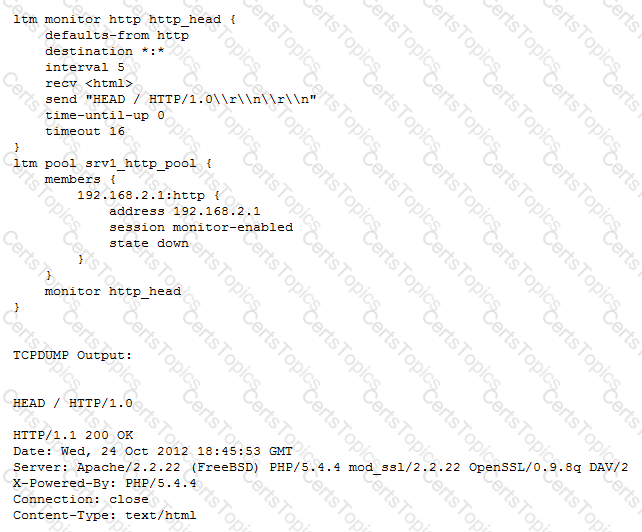
-- Exhibit --
Refer to the exhibit.
An LTM Specialist is troubleshooting a new HTTP monitor on a pool. The pool member is functioning correctly when accessed directly through a browser, although the monitor is marking the member as down. As part of the troubleshooting, the LTM Specialist has captured the monitor traffic via tcpdump.
How should the LTM Specialist resolve this issue?
A web server administrator informs the BIG-IP Administrator that web servers are overloaded Starting next month, the BIG-IP device will terminate SSL to reduce web server load. The BIG-IP device is ready using client SSL client profile and Rules on HTTP level. What actions should the BIG-IP Administrators to achieve the desired configuration?
How should a BIG-IP Administrator control the amount of traffic that a newly enabled pool member receives.
An LTM Specialist needs to apply SNAT using currently used SNAT pool to a new virtual server.
What needs to be completed before applying that configuration change?
-- Exhibit –
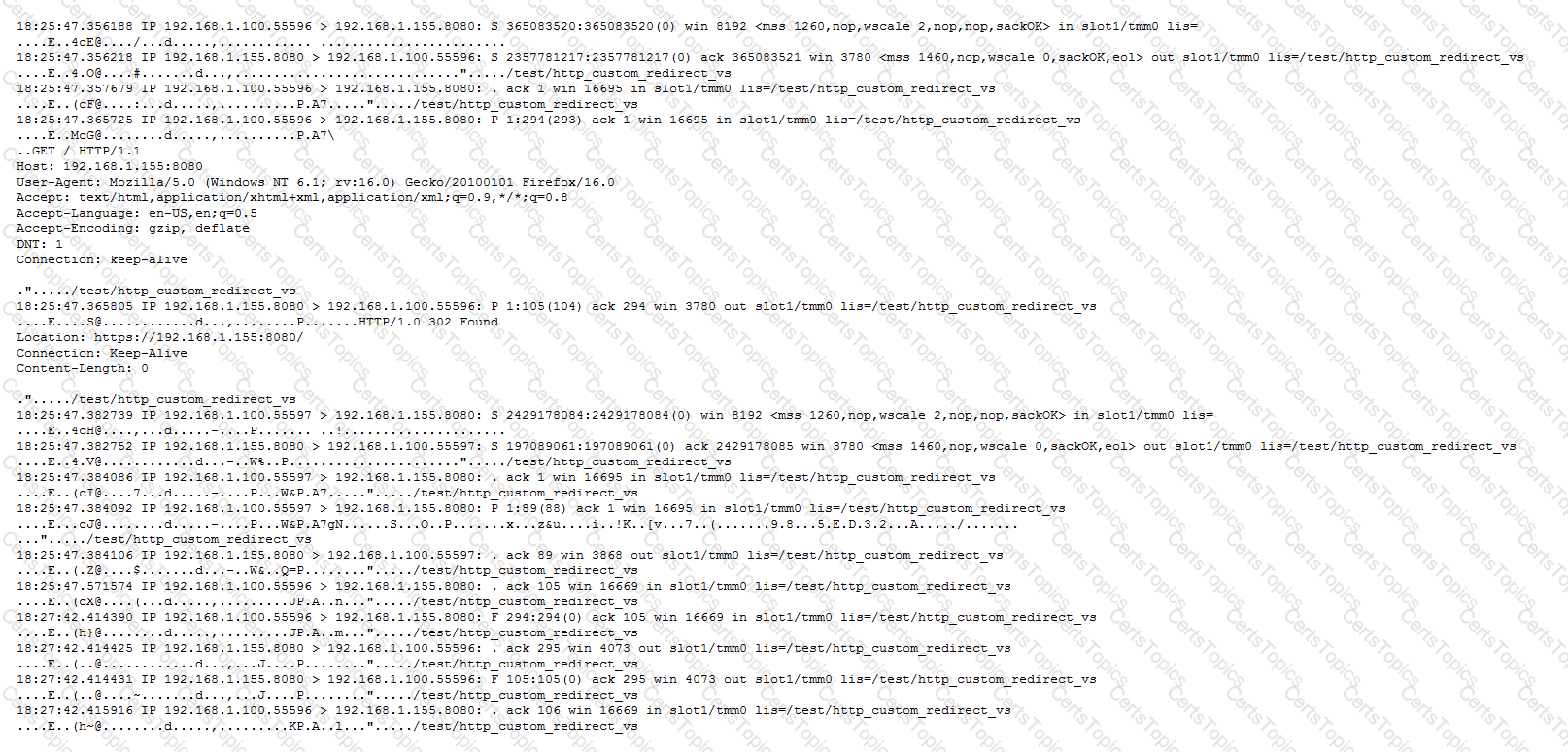
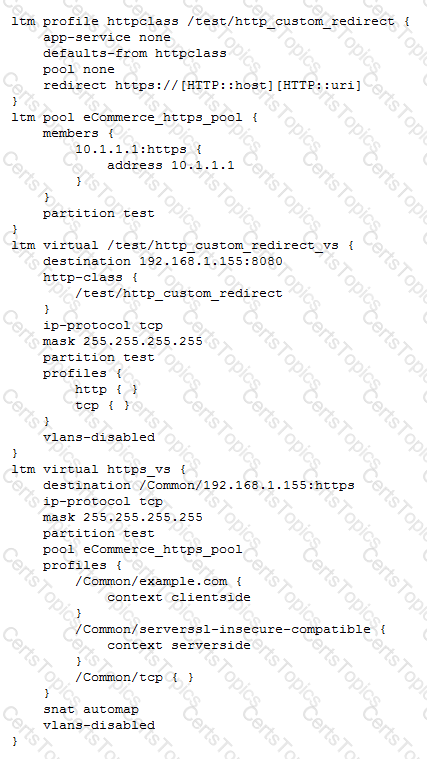
-- Exhibit --
Refer to the exhibits.
An LTM Specialist is reconfiguring a virtual server to redirect all clients to HTTPS. Testing reveals that the redirect is functioning incorrectly. As part of the troubleshooting process, the LTM Specialist performs a packet capture.
What is the issue?
Exhibit.

Webserver_pool consists of 6 members. phpAuction_80_pool consists of 2 members LTM1 is the current Activemember.
LTM1 loses connectivity to 3 of the 6 members in the webserver_pool LTM2 still has connectivity to all
servers.
What is the expected failover behavior?
An LTM Specialistconfigures a new HTTPS virtual server that contains a valid example.com ssl certificate. The LTM Special receives an error in the browser when connecting.
What must be added to the SSL Client profile to fix this issue?
An LI M device is experiencing a high volume of traffic. The virtual server is struggling under the load. The problem appears to be on the server side connections. The virtual server isaccepting connections . The virtual server is accepting connections on https and is configured with an SSL profile and http pool.
What should be added to increase the performance of the device?
-- Exhibit –
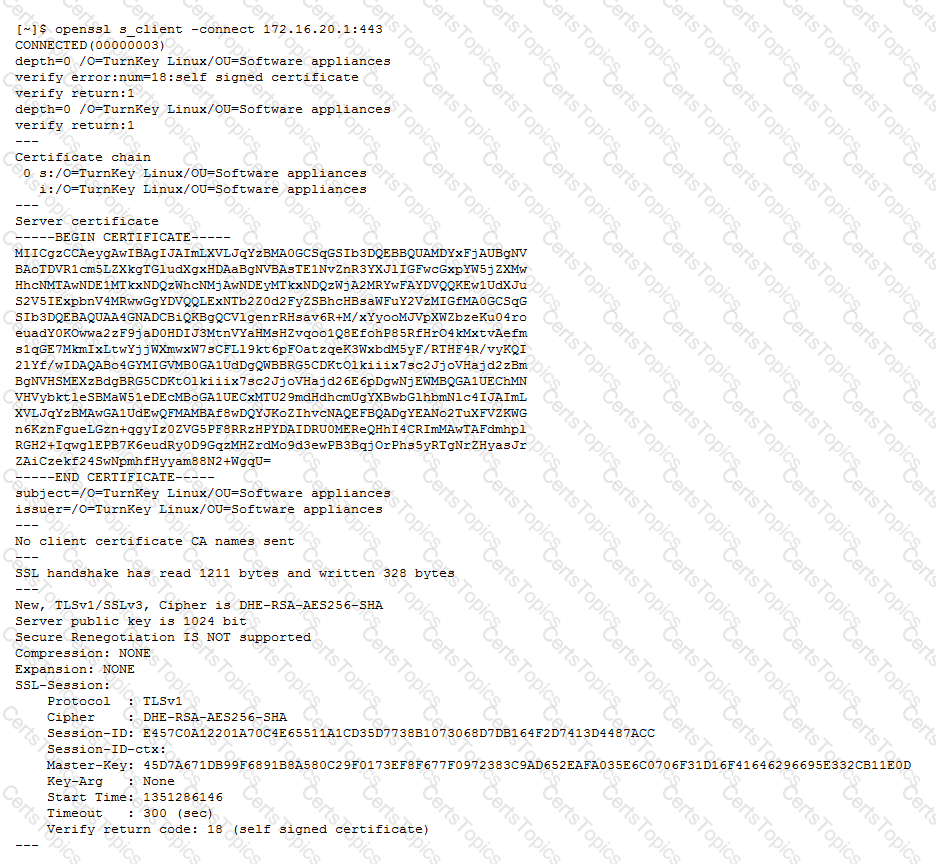
-- Exhibit --
Refer to the exhibit.
An LTM Specialist is troubleshooting an issue with SSL and is receiving the error shown when connecting to the virtual server. When connecting directly to the pool member, clients do NOT receive this message, and the application functions correctly. The LTM Specialist exports the appropriate certificate and key from the pool member and imports them into the LTM device. The LTM Specialist then creates the Client SSL profile and associates it with the virtual server.
What is the issue?
A BIG-IP Administrator has configured a BIG-IP cluster with remote user authentication against dcOl
f5trn.com. Only local users can successfully log into the system. Configsync is also failing.
Which two tools should the 8IG-IP Administrator use to further investigate these issues? (Choose two)
An LTM device has been configured to log the reasons for generating TCP RST packets.
The following log entry occurs:
"01230140:3: RST sent from 192.168.1.100:80 to 192.168.1.124:39272, [0x112d82a:1721] {peer} TCP RST from remote system."
Which condition will trigger this log entry?
-- Exhibit –
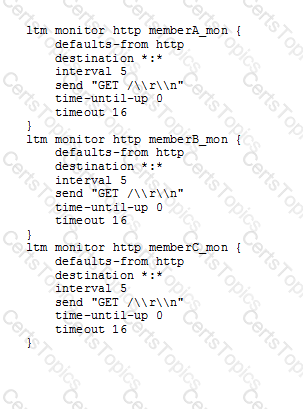
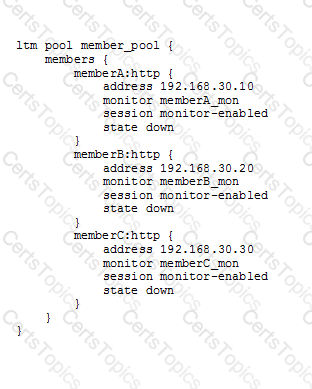
-- Exhibit --
Refer to the exhibits.
How should the LTM Specialist minimize the configuration?
Two LTM devices must be manually configured to restrict in the same Device Group.
What is the correct order of steps to meet this requirement?
-- Exhibit –
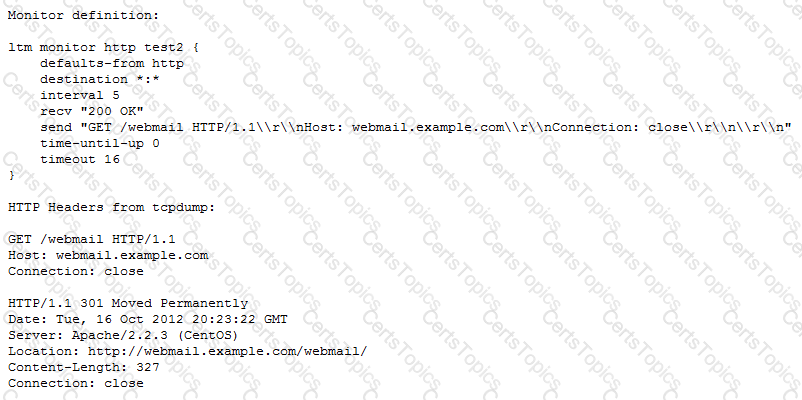
-- Exhibit --
Refer to the exhibit.
An HTTP monitor always marks the nodes in the pool as down. The monitor's definition and the HTTP headers from the monitor request and response are provided.
What is the issue?
Refer to the exhibit.
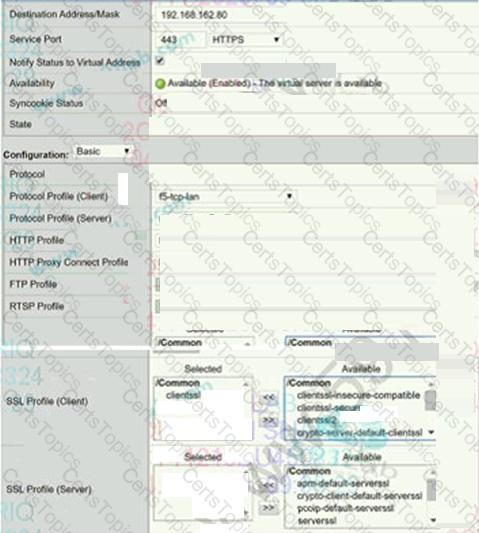
A BIG-IP Administrator needs to deploy an application on the BIG-IP system to perform SSL offload and
re-encrypt the traffic to pool members.
During testing, users are unable to connect to the application.
What must the BIG-IP Administrator do to resolve the issue?
Exhibit.

The three VLANS shown provide connectivity to backend servers. The backend servers are being moved to unmanaged switches and require separate interfaces.
How should the F5 device interfaces be configured?
When importing a PEM formatted SSL certificate, which text needs to appear first in the file?
-- Exhibit –
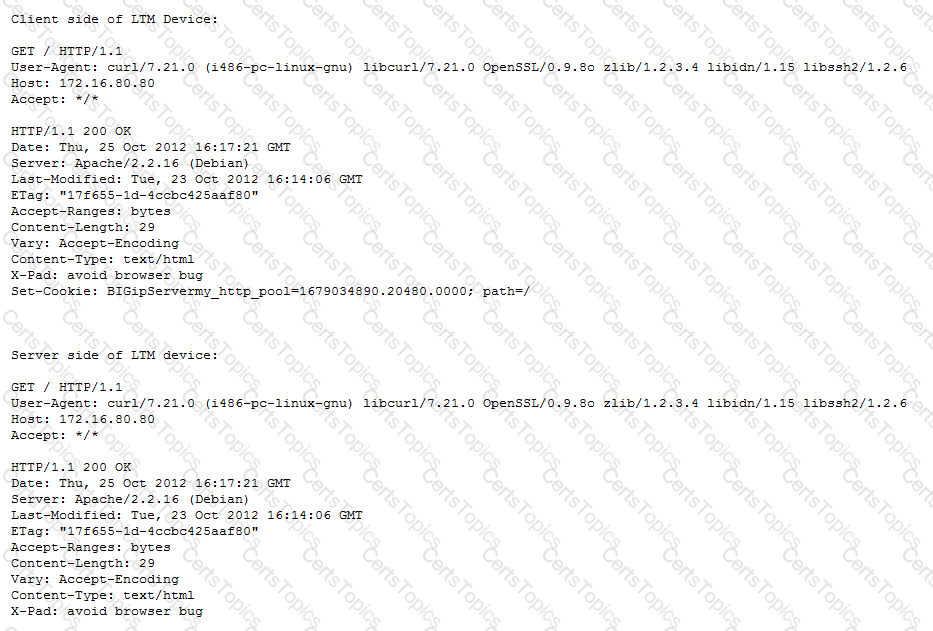
-- Exhibit --
Refer to the exhibit.
A web application is configured to allow sessions to continue even after a user computer is shut down for the night. A new LTM device is configured to load balance the web application to several servers. The application owner reports that application users are logged out of the web application whenever their browser is restarted or computer is rebooted.
What is the problem?
-- Exhibit –

-- Exhibit --
Refer to the exhibit.
An LTM Specialist sets up AVR alerts and notifications for a specific virtual server if the server latency exceeds 50ms. The LTM Specialist simulates a fault so that the server latency is consistently exceeding the 50ms threshold; however, no alerts are being received.
Which configuration should the LTM Specialist modify to achieve the expected results?
-- Exhibit –


-- Exhibit --
Refer to the exhibits.
An LTM Specialist is troubleshooting an issue with one of the virtual servers on an LTM device, and all requests are receiving errors. Testing directly against the server generates no errors. The LTM Specialist has captured the request and response on both client and server sides of the LTM device.
What should the LTM Specialist do to fix this issue?
Six servers have a varying number of connections that change based on the user load.
Which load balancing method should an LTM Specialist apply to divided the web application traffic to the servers on therelative performance trend?
-- Exhibit –
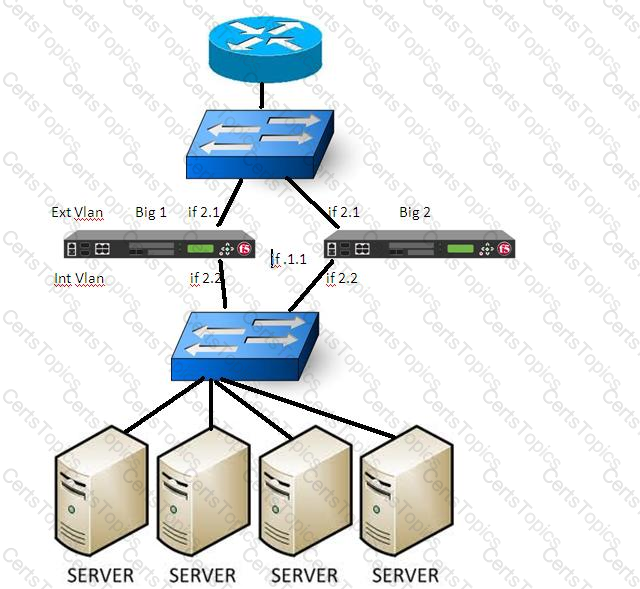
-- Exhibit --
Refer to the exhibit.
A failover has just occured on BIG-IP1. BIG-IP2 is now active and manages traffic as expected. Both Bigip's are set with a gateway failsafe to check the reachability of the main border router. Switches have performed as expected.
Where should the LTM Specialist check for potential issues?
An LTM Specialist configures a new virtual server with a single pool member. The LTM Specialist has NOT defined a health monitor for the pool, pool member or node.
What is the status of the virtual server?
-- Exhibit –
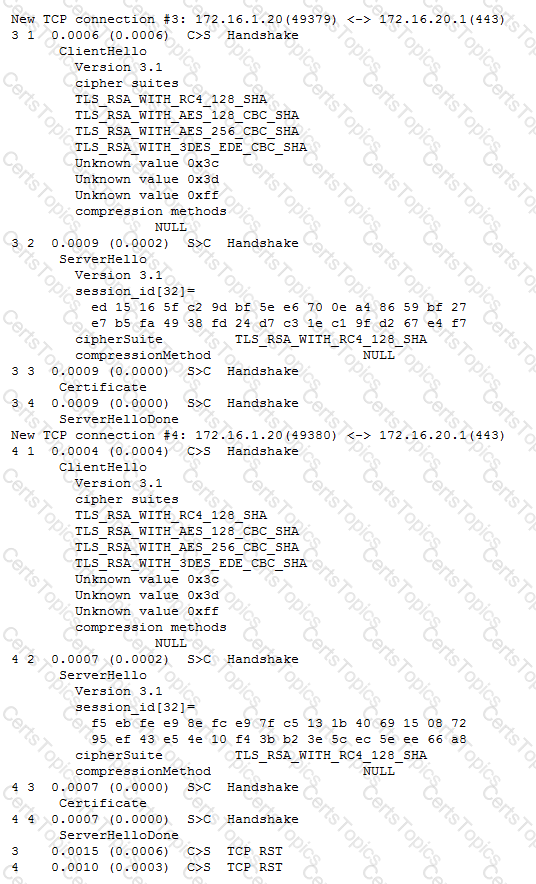
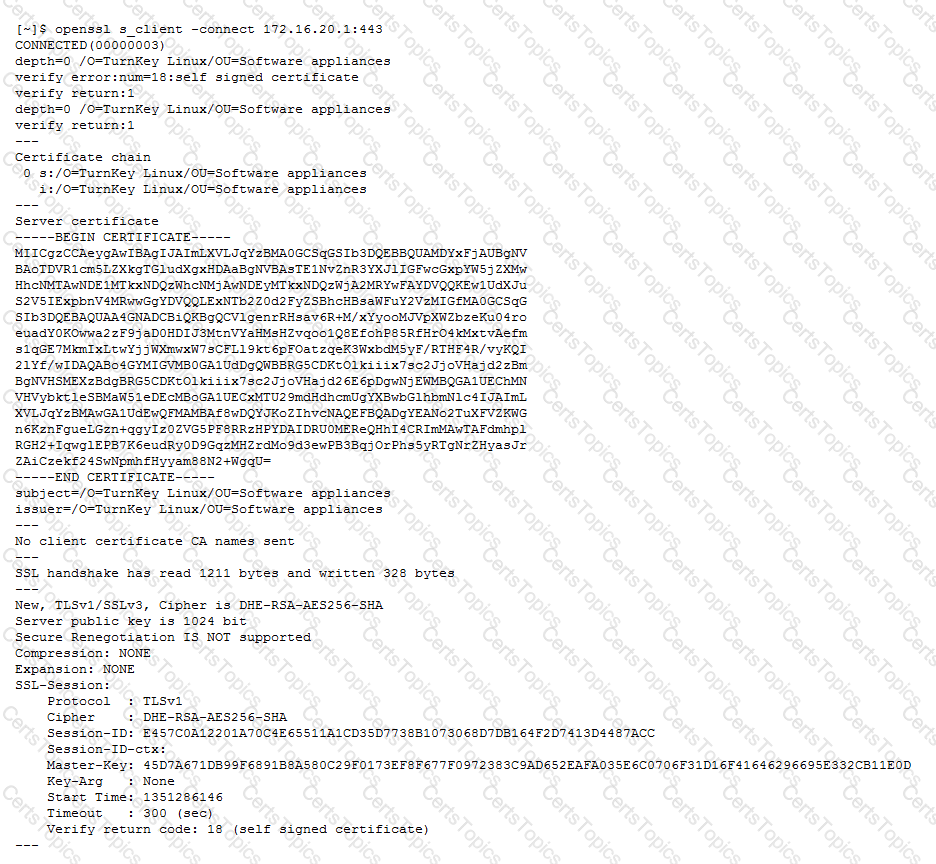
-- Exhibit --
Refer to the exhibits.
After upgrading LTM from v10 to v11, users are unable to connect to an application. The virtual server is using a client SSL profile for re-terminating SSL for payload inspection, but a server SSL profile is being used to re-encrypt the request.
A client side ssldump did NOT show any differences between the traffic going directly to the server and the traffic being processed by the LTM device. However, packet capture was done on the server, and differences were noted.
Which modification will allow the LTM device to process the traffic correctly?
A client is attempting to log in to a web application that requires authentication. The following HTTP headers are sent by the client:
GET /owa/ HTTP/1.1
Authorization: Basic dXNlcm5hbWU6cGFzc3dvcmQ=
User-Agent: curl/7.26.0
Host: 10.0.0.14
Accept: */*
Accept-EncodinG. gzip,deflate
The web server is responding with the following HTTP headers:
HTTP/1.1 401 Unauthorized
Content-TypE. text/html
Server: Microsoft-IIS/7.5
WWW-AuthenticatE. NTLM
DatE. Wed, 16 Aug 1977 19:12:31 GMT
Content-LengtH. 1293
The client has checked the login credentials and believes the correct details are being entered.
What is the reason the destination web server is sending an HTTP 401 response?
-- Exhibit –
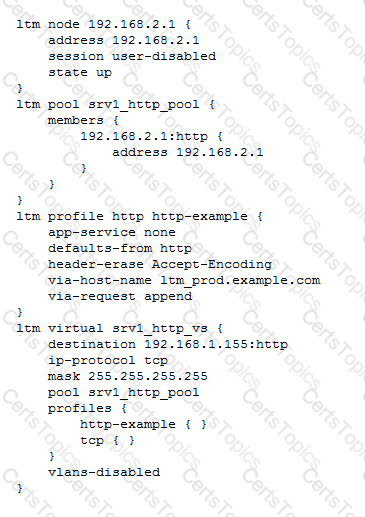
-- Exhibit --
Refer to the exhibit.
An LTM Specialist is troubleshooting a virtual server. Both the virtual server and the pool are showing blue squares for their statuses, and new clients report receiving "The connection was reset" through their browsers. Connections directly to the pool member are successful.
What is the issue?
A BIG-IP Administrator plans to resolve a non-critical issue with a BIG-IP device in 2 weeks. What Severity level should be assigned to this type of F5 support ticket?
A BIG-IP Administrator applied the latest hotfix to an inactive boot location by mistake, and needs to downgrade back to the previous hotfix.
What should the BIG-IP Administrator do to change the boot location to the previous hotfix?
-- Exhibit –
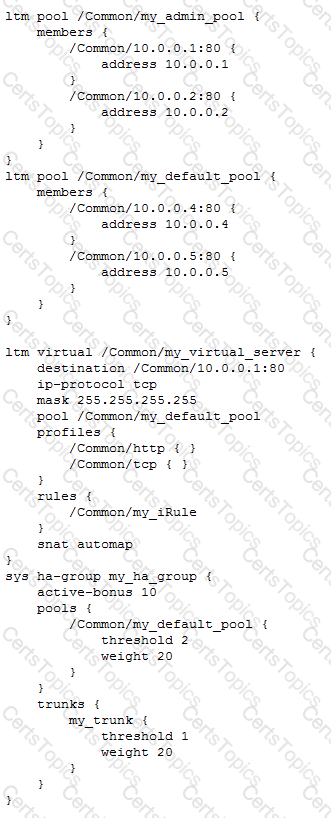
-- Exhibit --
Refer to the exhibit.
A pair of LTM devices is configured for HA.
What happens if the pool member server with IP address 10.0.0.4 becomes totally unresponsive to the active LTM device, but is still responsive to the standby LTM device?
An LTM deviceneeds to be configured a virtual server. The application requires SSL encryption from the client to the server and an X-Forwarded-For added by the LTM device.
Which virtual server type should the LTM Specialist use?
A 8IG-IP Administrator configures a Virtual Server to load balance traffic between 50 webservers for an
ecommerce website Traffic is being load balanced using the Least Connections (node) method.
The webserver administrators report that customers are losing the contents from their shopping carts
and are unable to complete their orders.
What should the BIG-IP Administrator do to resolve the issue?
An FTP monitor is NOT working correctly.
Which three pieces of information does the LTM Specialist need to provide to ensure a properly working FTP monitor? (Choose three.)
An LTM Specialist is troubleshooting an HTTP monitor. The pool member is accessible directly through a browser, but the HTTP monitor is marking the pool member as down.
GET / HTTP/1.1
HTTP/1.1 400 Bad Request
DatE. Tue, 23 Oct 2012 21:39:07 GTM
Server: Apache/2.2.22 (FreeBSD) PHP/5.4.4
mod_ssl/2.2.22 OpenSSL/0.9.8q DAV/2
Content-LengtH. 226
Connection: close
Content-TypE. text/html; charset=iso-8859-1
How should the LTM Specialist resolve this issue?
An LTM Specialist needs to provide access to a 8BG-IP to device for a company's support person access to the BIG IP device, but are NOT allowed to change any settings All support the support remote access to the BIG-IP device, but are NOTallowed to change ant settings. All support have accounts in the company's Active Directory
Which method is appropriate to provide access for the support personnel to the BIG-JP device?
An LTM Specialist is removing some of the load off an existing cluster by adding a adding a third BIG-IP
device to the device group. The new device candeliver twice the performance of the other two devices.
The LTM Specialist needs to make sure that the BIG-IP device with the highest available capacity is
always selected to take over a traffic group in the event of a failover.
Which failover method is most appropriate?
-- Exhibit –

-- Exhibit --
Refer to the exhibit.
Users report that a web application works incorrectly. Sometimes contextual data displayed on the web pages is accurate; other times it is inaccurate.
The LTM administrator looks at the connection table with a filter on one of the client IP addresses currently connected using the command "tmsh show sys connection cs-client-addr 10.0.20.1"
with the following results:
10.0.20.1:60048 10.0.20.88:80 10.0.20.1:60048 172.16.20.1:80 tcp 3 (tmm: 0)
10.0.20.1:60050 10.0.20.88:80 10.0.20.1:60050 172.16.20.3:80 tcp 3 (tmm: 0)
10.0.20.1:60047 10.0.20.88:80 10.0.20.1:60047 172.16.20.2:80 tcp 3 (tmm: 0)
10.0.20.1:60049 10.0.20.88:80 10.0.20.1:60049 172.16.20.1:80 tcp 3 (tmm: 0)
What is the solution to the problem?
The owner of a web application asks the 8IG-IP Administrator to change the port that the BIG-IP device sends traffic to. This change must be made for each member in the server pool named app_pool for their Virtual Server named app_vs. In which area of the BIG-IP Configuration Utility should the BIG-P Administrator make this change?
The LTM Specialist is writing a custom HTTP monitor for a web application and has viewed the content by accessing the site directly via their browser. The monitor continually fails. The monitor configuration is:
ltm monitor http /Common/exampleComMonitor {
defaults-from /Common/http
destination *:*
interval 5
recv "Recent Searches"
send "GET /app/feed/current\?uid=20145 HTTP/1.1\\r\\nHost: gzip, deflate\\r\\nConnection: close\\r\\n\\r\\n"
time-until-up 0
timeout 16
}
A trace shows the following request and response:
Request:
GET /app/feed/current?uid=20145 HTTP/1.1
Host
Accept-Encoding gzip, deflate
Connection: close
Response:
HTTP/1.1 302 Moved Temporarily
Date Wed, 17 Oct 2012 18:45:52 GMT
Server Apache
Location
Content-Encoding gzip
Content-Type text/html;charset=UTF-8
Set-CookiE. JSESSIONID=261EFFBDA8EC3036FBCC22D991AC6835; Path=/app/feed/current?uid=20145
What is the problem?
A web developer has created a custom HTTP call to a backend application. The HTTP headers being sent by the HTTP call are:
GET / HTTP/1.1
User-Agent: MyCustomApp (v1.0)
Accept: text/html
Cache-Control: no-cache
Connection: keep-alive
CookiE. somecookie=1
The backend server is responding with the following:
HTTP/1.1 400 Bad Request
DatE. Wed, 20 Jul 2012 17:22:41 GMT
Connection: close
Why is the HTTP web server responding with a HTTP 400 Bad Request?
An SSL application is being migrated to the LTM device. Both encrypted and unencrypted traffic are accepted by the server. The virtual server configuration is as follows:

Which LTM device profile should be used on the LTM device to reduce the CPU load on the current.
AN LTM Specialist needs to determine the delay between anLTM device and the internal web server for a specific client.
Which two AVR reporting options should the LTM Specialist enable to measure the delay? (Choose two.)
An HTTP 1.1 application utilizes chunking.
Which header should be used to notify the client's browser that there are additional HTTP headers at the end of the message?
In an iApp, which configuration protects against accidental changes to an application Services configuration?
What does the following iRule do?
when CLIENT_ACCEPTED {
if { [matchclass [IP::client_addr] equals WebClient1-Whitelist1] }{
#log local0. "Valid client IP: [IP::client_addr] - forwarding traffic"
#Pool WebClient1
} else {
log local0. "Invalid client IP: [IP::client_addr] - discarding"
discard
}
}
An LTM Specialist has a OneConnect profile and HTTP profile configured on a virtual server to load balance an HTTP application.
The following HTTP headers are seen in a network trace when a client connects to the virtual server:
Clientside:
GET / HTTP/1.1
Host: 192.168.136.100
User-Agent: Mozilla/5.0
Accept: text/html,application/xhtml+xml,application/xml;q=0.9,*/*;q=0.8
Accept-EncodinG. gzip, deflate
Connection: keep-alive
Serverside:
HTTP/1.1 200 OK
DatE. 5 Jun 1989 17:06:55 GMT
Server: Apache/2.2.14 (Ubuntu)
Vary: Accept-Encoding
Content-EncodinG. gzip
Content-LengtH. 3729
X-Cnection: close
Content-TypE. text/html
The LTM Specialist notices the OneConnect feature is working incorrectly.
Why is OneConnect functioning incorrectly?
A client (10.10.1.30) connecting to an HTTPS virtual server (10.10.1.100) with a clientssl profile is getting an SSL error.
Which options will trace this issue?
-- Exhibit –

-- Exhibit --
Refer to the exhibit.
An LTM Specialist configures a virtual server that balances HTTP connections to a pool of three application servers. Approximately one out of every three connections to the virtual server fails.
Which two actions will resolve the problem? (Choose two.)
Which iRule statement demotes a virtual server from CMP?
A 816-IP Administrator recently deployed an application Users are experiencing slow performance with
the application on some remote networks.
Which two modifications can the BIG-IP Administrator make to address this issue? (Choose two)
The picture belongs to static content, you can configure static content cache in FS to meet this demand
An LTM Specialist must configure session persistence for a highly available, highly utilized web-based application.
* The following requirements are provided:
* http proxy setup for security
persistence information available to the HA peer in case of failover
The LTM Specialist needs to minimize additional burden on the LTM device to the greatest extent possible.
Which persistence profile should be used?
An application is configured so that the same pool member must be used for an entire session, as well as for HTTP and FTP traffic.
A user reports that a session has terminated, and the user must restart the session. The BIG-IP Administrator determines that the active BIG-IP device failed over to the standby BIG-IP device. Which configuration settings should the BIG-IP Administrator verify to ensure proper behaviour when BIG-IP failover occurs?
An LTM device is running BIG-IP v10.2.0 software. The LTM Specialist is tasked with upgrading the LTM device to BIG-IP v11.2.0 HF1. The LTM Specialist starts the upgrade process by selecting the uploaded Hotfix and installing to an unused volume. After 10 minutes, the LTM Specialist checks the status of the upgrade process and notices that the process is stalled at 0%.
What should the LTM Specialist verify?
The BIG-IP Administrator disable all pool members in a pool Users are still able to reach the pool
members.
What is allowing users to continue to reach the disabled poo! members?